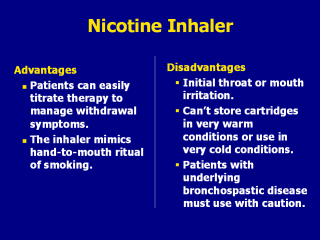| front |1 |2 |3 |4 |5 |6 |7 |8 |9 |10 |11 |12 |13 |14 |15 |16 |17 |18 |19 |20 |21 |22 |23 |24 |25 |26 |27 |28 |29 |30 |31 |32 |33 |34 |35 |36 |37 |38 |39 |40 |41 |review |
 |
Advantages of the nicotine inhaler include the
following: Patients can easily titrate therapy to manage withdrawal symptoms. The inhaler mimics the hand-to-mouth ritual of smoking. Disadvantages of the inhaler include the following: Initial throat or mouth irritation (generally in first week) can be bothersome. Cartridges should not be stored in conditions exceeding 86°F or be used below 59°F because the delivery system may be compromised at temperatures outside this range. Patients with underlying bronchospastic conditions should use the nicotine inhaler with caution. Other forms of NRT may be preferred for patients with severe bronchospastic airway disease (e.g., severe asthma or chronic obstructive pulmonary disease) because the nicotine vapor may be irritating and provoke bronchospasm. Slide is used with permission, Rx for Change: Clinician-Assisted Tobacco Cessation. Copyright © 1999-2007 The Regents of the University of California, University of Southern California, and Western University of Health Sciences. All rights reserved. |